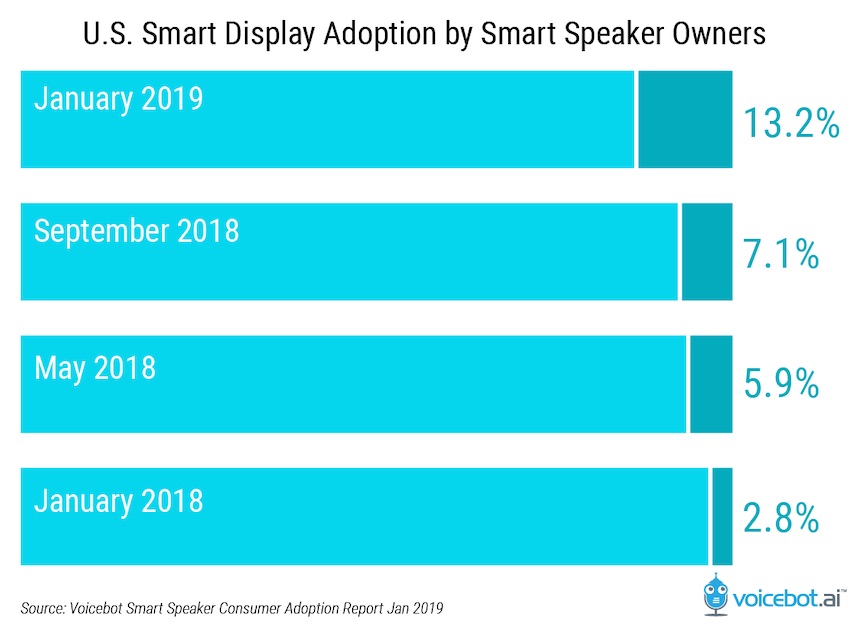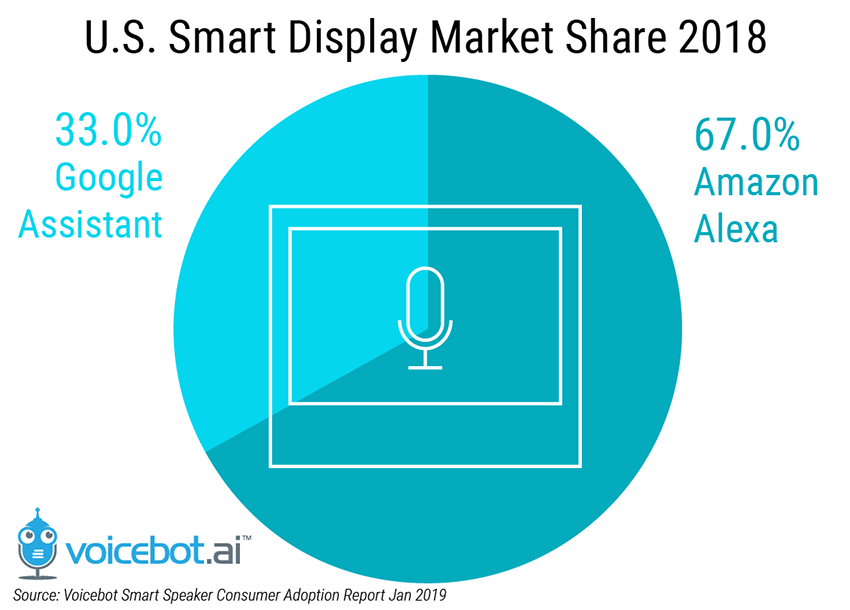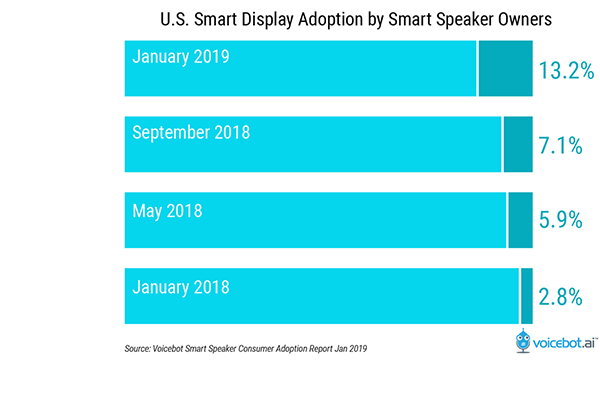U.S. Smart Display User Base Grew 558% in 2018 and More Than Doubled in Second Half of the Year, Amazon Holds Two-thirds Market Share
The installed user base for voice-interactive smart displays among U.S. adults rose 558% in 2018 according to a national survey conducted by Voicebot and Voicify and presented in the 2019 U.S. Smart Speaker Consumer Adoption Report. In addition, the relative share of smart speaker owners with a display more than doubled in the second half of the year.
Voicebot survey data indicated about 2.8% of smart speaker owners also had a smart display in January 2018. By late May that figure had risen to about 5.9% and it rose again to 7.1% in early September. What was behind that growth? In the first two quarters of 2018, Amazon frequently offered heavy discounts on its smart displays in anticipation of introducing a second generation display in September and the expectation of competitive products. There were the January announcements of several OEMs committed to introducing Google Assistant enabled smart displays which did launch in July and August. However, the growth accelerated further during the U.S. holiday shopping season when a number of new smart displays first became available such as the Google Home Hub and Facebook Portal. At the end of 2018, 13.2% of smart speaker owners counted a smart display among their voice-interactive devices.

Total User Numbers Rose Faster Than Relative Share
There are two ways to look at smart display numbers. One is the relative number of smart speaker owners that also own a display. A second is the total number of users. Since the overall smart speaker user base was growing so quickly during 2018, the relative share increase of 370% was dwarfed by the total user base rise of 558%. In January of 2018, there were about 1.3 million smart display owners in the U.S. By the end of 2018 that figure had risen to 8.7 million. Bob Naughton, CRO of Voicify commented,
The exponential growth of this device isn’t surprising. As humans, we rarely use a single modality when communicating with each other and we expect the same from our devices and technologies.
Use Cases and Choice Made the Difference
It was unclear when Echo Show first launched in June 2017 whether consumers would find the presence of a screen a necessity. Smart speakers were already popular for playing music, answering weather-related questions, and setting timers. Adding a visual element to the voice-interactive experience did offer an enhanced experience, but it was often unnecessary for the core use case. However, some changes in the market transpired in late 2017 and throughout 2018.
First, the Echo Spot was introduced for a specific use case, the bedside nightstand clock replacement. By summer of 2018, that device had already outsold the Echo Show which had been available for twice as long. Second, new options were introduced. Amazon’s two smart display were the only products in the category in the first half of 2018. If you didn’t want an Alexa-enabled smart display, you had to wait.
Lenovo Smart Display was introduced in July, JBL LinkView in August, Amazon Echo Show 2nd Gen in September, and Facebook Portal and Google Home Hub in October. More devices trickled into the market later in the year. Suddenly, consumers had many choices, including three backed by big ad campaigns from Amazon, Facebook, and Google.
And, Facebook introduced Portal as purpose-built for video chat while Google Home Hub had the dual positioning as a smart home command center and a digital picture frame for Google Photos collections. Amazon SVP David Limp suggested Echo Show was a kitchen television replacement. More consumer choices combined with clearer use cases and aggressive discounting spurred consumer demand when they were ready to buy something different and interesting for holiday gift giving.
Amazon Commands Two-Thirds of U.S. Smart Display User Base
Amazon is the dominant smart display provider in the U.S. today with two-thirds of the installed user base. It built that lead based on being first to market in the product category by more than a year and by complementing the most popular smart speaker ecosystem. Interestingly, in many countries where smart speakers are introduced, the first mover often has a two-thirds market share six-to-twelve months after a competing product is introduced. We are currently seeing the same pattern with smart displays.

Amazon has thus far been largely on its own in terms of smart display partners whereas Google has many. Amazon manufactured about 100% of all Alexa-enabled smart displays in 2018, but Google only accounted for about only 38.5% of Google Assistant-enabled devices in the category. Trends to watch for are whether Amazon’s new smart display partners announced in late 2018 and early 2019 will help it maintain market share or if smart display share starts to converge with the company’s overall smart speaker share.
Where Smart Displays Still Come Up Short
Smart displays had a good year in 2018, but it is still safe to say their future is unclear for two reasons: smart TVs may displace some smart display use cases and there is still very little content optimized for the voice-interactive images. Smart TVs are a long way from having the seamless integration of voice interaction as smart displays, but for entertainment use cases this gap is narrowing quickly. If you look at what Google Assistant and Bixby are doing with smart TV integration, you can see that smart displays will soon have little usefulness in rooms where a large screen is already present.
Another issue is the lack of content developed for smart displays. There are a lot of Alexa skills and Google Actions optimized for voice-only interaction and some have nominal additional features when a display is detected on the device. However, aside from a few recipe and gaming voice apps, display-oriented content is rare. Amazon’s Alexa Presentation Language could help seed the market with more image-ready voice experiences, but content developers still need to commit to the multimodal design at a time when many still haven’t grasped how to take full advantage of voice-only user experiences.
The rapid rise in smart display ownership does now provide an incentive for content providers and voice app publishers to build for an audience that is starting to show some signs of scale. Plus, the deeper integration of smart TVs with voice assistants should accelerate the value of voice-plus-visual interaction even faster. There are now many smart display choices for consumers so the key barrier holding back multimodal interactions hinges on content optimized for these use cases.
You can learn more by downloading the 2019 U.S. Smart Speaker Consumer Adoption report below.
Download Now
Follow @bretkinsella Follow @voicebotai
Google Duplex Now in 43 States, Coming to iOS and Other Android Smartphones









